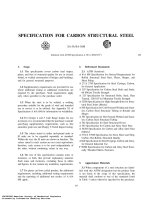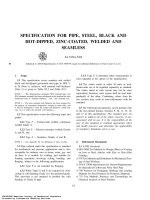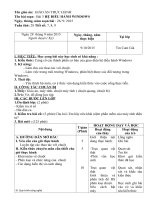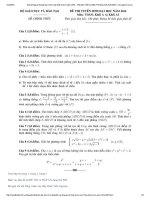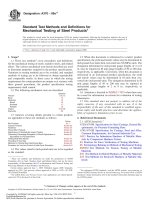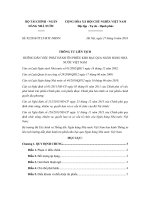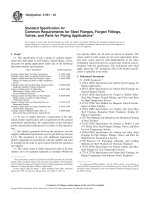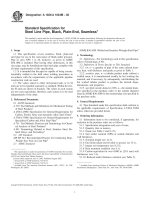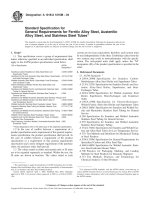Astm a 686 92 (2016)
Bạn đang xem bản rút gọn của tài liệu. Xem và tải ngay bản đầy đủ của tài liệu tại đây (143.67 KB, 12 trang )
Designation: A686 − 92 (Reapproved 2016)
Standard Specification for
Tool Steel, Carbon1
This standard is issued under the fixed designation A686; the number immediately following the designation indicates the year of
original adoption or, in the case of revision, the year of last revision. A number in parentheses indicates the year of last reapproval. A
superscript epsilon (´) indicates an editorial change since the last revision or reapproval.
This standard has been approved for use by agencies of the U.S. Department of Defense.
2.2 Military Standard:4
MIL-STD-163 Steel Mill Products, Preparation for Shipment and Storage
2.3 Federal Standards:4
Fed. Std. No. 123 Marking for Shipment (Civil Agencies)
Fed. Std. No. 183 Continuous Identification Marking of Iron
and Steel Products
1. Scope
1.1 This specification covers the chemical, mechanical, and
physical requirements for available wrought carbon tool steel
products.
1.2 These products, which include hot- or cold-finished bar,
plate, sheet, rod, wire, or forgings, are normally fabricated into
tools, dies, or fixtures. The selection of a material for a
particular application will depend upon design, service
conditions, and desired properties.
3. Classification
3.1 Material in accordance with this specification is classified by chemical composition. Types correspond to respective
AISI designations.
3.1.1 Carbon Tool Steels, Identification W—Types W1, W2,
and W5 are often referred to as water hardening tool steels
since they require rapid quenching rates to attain the necessary
hardness. Except in very small sizes they will harden with a
hard case and a soft core.
3.1.1.1 Type W1 is an unalloyed carbon steel available in
several carbon ranges.
3.1.1.2 Type W2 is characterized by a nominal vanadium
content of 0.25 % and is also available in several carbon
ranges.
3.1.1.3 Type W5 is characterized by a nominal chromium
content of 0.50 %.
3.1.1.4 A suffix following the type designation is added to
denote the minimum carbon content of the carbon range to be
specified.
3.1.2 Types W1 and W2 are further classified by quality
levels, namely, Grade A and Grade C.
3.1.2.1 Grade A is sometimes referred to as Extra or Special.
It is controlled for hardenability; the chemical composition is
held to closest limits; and it is subject to rigid tests to ensure
uniformity. Grade A is available with three degrees of
hardenability, namely, shallow hardening, regular hardening,
and deep hardening.
3.1.2.2 Grade C is sometimes referred to as Regular or
Standard. It is intended for applications that do not require
controlled hardenability and where some latitude in uniformity
is permissible.
1.3 The values stated in inch-pound units are to be regarded
as standard. The values given in parentheses are mathematical
conversions to SI units that are provided for information only
and are not considered standard.
2. Referenced Documents
2.1 ASTM Standards:2
A370 Test Methods and Definitions for Mechanical Testing
of Steel Products
A388/A388M Practice for Ultrasonic Examination of Steel
Forgings
A561 Practice for Macroetch Testing of Tool Steel Bars
A700 Guide for Packaging, Marking, and Loading Methods
for Steel Products for Shipment
E3 Guide for Preparation of Metallographic Specimens
E30 Test Methods for Chemical Analysis of Steel, Cast Iron,
Open-Hearth Iron, and Wrought Iron (Withdrawn 1995)3
E45 Test Methods for Determining the Inclusion Content of
Steel
E59 Practice for Sampling Steel and Iron for Determination
of Chemical Composition (Withdrawn 1996)3
1
This specification is under the jurisdiction of ASTM Committee A01 on Steel,
Stainless Steel and Related Alloys and is the direct responsibility of Subcommittee
A01.29 on Tool Steels.
Current edition approved March 1, 2016. Published June 2016. Originally
approved in 1973. Last previous edition approved in 2010 as A686 – 92 (2010).
DOI: 10.1520/A0686-92R16.
2
For referenced ASTM standards, visit the ASTM website, www.astm.org, or
contact ASTM Customer Service at For Annual Book of ASTM
Standards volume information, refer to the standard’s Document Summary page on
the ASTM website.
3
The last approved version of this historical standard is referenced on
www.astm.org.
4
Available from DLA Document Services, Building 4/D, 700 Robbins Ave.,
Philadelphia, PA 19111-5094, .
Copyright © ASTM International, 100 Barr Harbor Drive, PO Box C700, West Conshohocken, PA 19428-2959. United States
1
A686 − 92 (2016)
midway between the center and surface in accordance with the
latest issue of Practice E59. The chemical analysis of the
drilling chips shall be made in accordance with the latest issue
of Test Methods E30. The chemical composition thus determined shall not vary from the limits specified in Table 1.
4. Ordering Information
4.1 Orders for material under this specification shall include
the following information, as required to describe adequately
the desired material:
4.1.1 Class of material (carbon tool steel),
4.1.2 Type (W1, W2, W5),
4.1.3 Suffix denoting carbon range (where applicable, such
as W1–9, W2–10, etc.),
4.1.4 Grade and hardenability (where applicable, for
example, Grade A deep hardening, and so forth),
4.1.5 Shape (sheet, plate, flat bar, round bar, square bar,
hexagon bar, octagon, special shapes),
4.1.6 Dimensions (thickness, width, diameter, length),
4.1.7 Finish (hot rolled, forged, blasted or pickled, cold
drawn, machined, ground, precision ground and polished),
4.1.8 Condition (annealed, unannealed, hardened and
tempered, and so forth),
4.1.9 ASTM specification number and date of issue, and
4.1.10 Special requirements.
7. Hardness Properties
7.1 Annealed hardness values shall be obtained in accordance with the latest issue of Test Methods and Definitions
A370, and shall not exceed the Brinell hardness values (or
equivalent Rockwell hardness values) specified in Table 2.
7.2 Specimens for determination of minimum response to
hardening shall be ¼-in. (6.4-mm) thick disks cut so as to
represent either the full cross-sectional area or that midway
between the center and outer surface of the material. If the
material form or size does not lend itself to accurate hardness
determination on ¼-in. (6.4-mm) thick cross-sectional disks,
then longitudinal specimens may be used for hardness testing.
Examples are round bars less than 1⁄2 in. (12.7 mm) in diameter
or sheet. In this case, the specimen shall be a minimum of 3 in.
(76.2 mm) in length and parallel flats shall be ground on the
original mill surfaces. The specimens shall be heat treated as
prescribed in Table 3.
7.2.1 The hardness of the specimen after the specified heat
treatment shall meet the minimum hardness value for the
particular type of steel shown in Table 3. Rockwell C tests
should be used where possible but light load tests may be
necessary on thin specimens. These tests should be specified by
agreement between seller and purchaser. The hardness value
shall be obtained in accordance with the latest issue of Test
Methods and Definitions A370, and shall be the average of at
least five readings taken in an area midway between the center
and surface of the largest dimension of the cross-sectional
specimen or along the parallel surfaces of the longitudinal
specimen. The surface to be tested shall be ground sufficiently
to remove any surface condition, scale, carburization, or
decarburization which might affect readings.
5. Materials and Manufacture
5.1 Unless otherwise specified, material covered by this
specification shall be made by an electric melting process. It
shall be made from ingots that have been reduced in cross
section in such a manner and to such a degree as to ensure
proper refinement of the ingot structure.
6. Chemical Composition
6.1 An analysis of each heat of steel shall be made by the
manufacturer to determine the percentage of the elements
specified and these values shall conform to the chemical
composition specified in Table 1. If requested or required, the
chemical composition shall be reported to the purchaser or his
representative.
6.2 Analysis may be made by the purchaser from finished
bars and forgings by machining off the entire cross section and
drilling parallel to the axis of the bar or forging at any point
TABLE 1 Chemical Composition, %A
A
B
UNS
Designation
Type
Grade
T72301
T72301
T72302
T72302
T72305
W1
W1
W2
W2
W5
A
C
A
C
...
min
max
min
max
min
max
B
B
B
B
C
C
0.10
0.10
0.10
0.10
0.10
0.40
0.40
0.40
0.40
0.40
0.10
0.10
0.10
0.10
0.10
0.40
0.40
0.40
0.40
0.40
0.030
0.030
0.030
0.030
0.030
C
C
1.05
1.15
Silicon
Sulfur,
max
0.030
0.030
0.030
0.030
0.030
max
Tungsten,
max
Molybdenum,
max
Copper,
max
Nickel,
max
0.10
0.10
0.35
0.35
0.10
0.15
0.15
0.15
0.15
0.15
0.10
0.10
0.10
0.10
0.10
0.20
0.20
0.20
0.20
0.20
0.20
0.20
0.20
0.20
0.20
Chromium
Vanadium
min
max
min
...
...
...
...
0.40
0.15
0.30
0.15
0.30
0.60
...
...
0.15
0.15
...
Chemistry limits include product analysis tolerances.
The carbon ranges for W1 and their respective suffix identification, sometimes referred to as tempers, are as follows:
Suffix
8
8 1⁄ 2
9
9 1⁄ 2
C
Manganese
Phosphorus,
max
Carbon
Carbon Range, %
0.80–0.90
0.85–0.95
0.90–1.00
0.95–1.05
Suffix
10
101⁄2
11
111⁄2
Carbon Range, %
1.00–1.10
1.05–1.15
1.10–1.20
1.15–1.25
The carbon ranges for W2 and their respective suffix identification are as follows:
Suffix
81⁄2
9
9 1 ⁄2
13
Carbon Range, %
0.85–0.95
0.90–1.00
0.95–1.10
1.30–1.50
2
A686 − 92 (2016)
TABLE 2 Maximum Brinell Hardness in Annealed or Cold Drawn
Condition
Type
W1
W2
W5
Annealed BHN
202
202
202
Drill Rod (W1, W2, or W5)
Ordered Diameter, in. (mm)
To 1⁄8 (3.2)
Over 1⁄8 to 1⁄4 (3.2 to 6.4), incl
Over 1⁄4 to 1⁄2 (6.4 to 12.7), incl
Over 1⁄2 (12.7)
Cold Drawn BHN
241
241
241
Brinell
HB
HB
HB
HB
given in Tables 5-9 for the appropriate size and shape of
material. Lower limits of decarburization may be specified by
agreement between the seller and purchaser.
341
275
241
207
9.2 Material ordered as ground and polished or ground
finished or machine finished shall be free of scale and
decarburization.
Rockwell
HRC
HRC
HRC
HRB
37
28
23
96
10. Permissible Variations for Dimensions
10.1 Permissible variations for dimensions shall not exceed
the applicable limits stated in Table 6, and Tables 10-22 and
Note 1.
NOTE 1—Unmachined tool steel forgings are furnished to size and
surface allowances for machining and tolerances over allowances. Experience indicates that the allowances and tolerances in the tabulation below
are satisfactory for many applications. When width and thickness differ,
each dimension carries its individual allowance and tolerance in accordance with the tabulation: also, the ID and OD take their respective
allowances and tolerances. When forgings are ordered, the purchaser
should state whether the sizes are the forged or the finished sizes. The
minimum sizes ordered for forgings should be the finished sizes plus
allowances for machining; and the ordered forged sizes are subject to
applicable tolerances
7.2.2 Hardness penetration and fracture grain size for Grade
A shall be determined on test pieces of 3⁄4 in. (19.1 mm)
diameter and 3 in. (76.2 mm) length. Two pieces for each test
shall be given a preliminary treatment by heating uniformly to
1600 6 10°F (871 6 5°C) and holding at temperature for
40 min, then quenching in oil. One piece shall be reheated to
1450 6 10°F (788 6 5°C) and the other to 1550 6 10°F
(843 6 5°C). Each piece shall be held in the furnace at the
respective temperature for 30 min and then quenched in brine
(5 to 10 % sodium chloride solution). The pieces shall be
nicked with an abrasive wheel in the center of the length and
fractured. The fracture face of one portion of each broken test
piece shall be ground smooth and etched in 1 + 1 muriatic acid
at 165°F (74°C) for measurement of the depth of penetration to
be expressed in 64ths of an inch. The fracture grain size shall
be determined on the remaining portion of each broken test
piece by comparison of the fracture surface of the hardened
case with the Shepherd Fracture Grain Size Standards.5 These
standards consist of ten pieces of steel with fracture faces
representing graduated grain sizes from the coarsest (No. 1) to
the finest (No. 10). The fracture grain size is estimated to the
nearest quarter number. The hardness penetration and fracture
grain size for Grade A shall meet the requirements shown in
Table 3.
10.2 Out-of-round tolerances for round bars shall be one
half the permissible dimensional variations stated in Table 6,
Table 10, Table 12, Table 14, Table 15, and Table 17.
11. Workmanship, Finish, and Appearance
11.1 All carbon tool steels shall be free of heavy scale, deep
pitting, laps, porosity, injurious segregations, excessive nonmetallic inclusions, seams, cracks, checks, slivers, scale marks,
dents, soft and hard spots, pipes, or any defects that would
detrimentally affect the suitability of the material after removal
of the recommended stock allowance.
12. Sampling
12.1 Each particular shipment of a heat of steel by type,
size, and shape shall be considered a lot and must conform to
the provisions of this specification.
8. Macrostructure
13. Inspection
8.1 The macrostructure of a specimen representing the
entire cross-sectional area in the annealed condition shall be
prepared in accordance with the latest issue of Practice A561.
It shall exhibit a structure free of excessive porosity,
segregation, slag, dirt or other nonmetallic inclusions, pipes,
checks, cracks, and other injurious defects.
8.2 Macroetch severity levels for center porosity and ingot
pattern, illustrated photographically in Practice A561, shall not
exceed the ratings specification in Table 4 for the appropriate
material size and composition. More stringent requirements are
available by agreement between seller and purchaser.
13.1 When specified in the purchase order, the inspector
representing the purchaser shall have access to the material
subject to inspection for the purpose of witnessing the selection
of samples, preparation of test pieces, and performance of the
tests. For such tests, the inspector shall have the right to
indicate the pieces from which samples will be selected.
Otherwise, the seller shall report to the purchaser, or his
representative, the results of the chemical analysis and the
physical and mechanical property tests made in accordance
with this specification.
9. Decarburization
14. Rejection and Rehearing
9.1 Decarburization shall be determined on a specimen
representing a cross section of the material and prepared in
accordance with the latest issue of Guide E3. When examined
at 20× or greater magnification it shall not exceed the values
14.1 Unless otherwise specified, any rejections based on
tests made in accordance with this specification shall be
reported to the seller within 30 days from the date of receipt of
the material.
14.2 Material that shows injurious defects subsequent to its
acceptance by the purchaser shall be rejected and the seller
notified.
5
The Shepherd Fracture Gain Size Standards may be purchased from Metallurgical Services, Inc., Box 1075, 925 Main St., Niagara Falls, NY 14302.
3
A686 − 92 (2016)
TABLE 3 Heat-Treating Requirements
Type
Carbon Range, %
W1
0.70–0.85
0.85–0.95
0.95–1.50
0.85–0.95
0.95–1.50
1.05–1.15
W2
W5
Specified
Depth of
Hardening
1450 (788)
1550 (843)
Regular
1450 (788)
1550 (843)
Deep
A
1475 (802)
1475 (802)
1450 (788)
1475 (802)
1450 (788)
1475 (802)
Hardness Penetration and Fracture Grain Size for Grade A
W1 (0.70 to 0.95 C)
Quench
Temperature,
°F (°C)
Shallow
Austenitizing Temperature,
°F (°C)
Penetration 64th in.
10 max
not more than 5⁄64 deeper
than at 1450
9 to 13
not more than 8⁄64 deeper
than at 1450
12 min
not more than 10⁄64 deeper
than at 1450
1450 (788)
1550 (843)
W2 (0.85 to 0.95 C)A
Grain Size
(Shepherd) Not
Coarser Than
8
6 1 ⁄2
8
6 1 ⁄2
8
61⁄2
Minimum
Hardness,
HRC
brine
brine
brine
brine
brine
brine
64
65
65
65
65
65
W1 (0.95 to 1.10 C)
W2 (0.95 to 1.10 C)A
Penetration 64th in.
8 max
not more than 5⁄64 deeper
than at 1450
7 to 11
not more than 8⁄64 deeper
than at 1450
10 to 16
not more than 10⁄64 deeper
than at 1450
W1 (1.10 to 1.30 C)A
Grain Size
(Shepherd) Not
Coarser Than
8 1⁄ 2
6 1⁄ 2
81 ⁄ 2
6 1⁄ 2
8
61⁄2
Applicable to shallow and regular hardening material only.
TABLE 4 Macroetch Standards
Maximum Allowable RatingA
from the date of the test report. In case of dissatisfaction with
the results of the test, the seller may make claim for a rehearing
within that time.
Carbon Tool Steels
Size Round, in. (mm)
Porosity
Up to 2 (50.8), incl
Over 2 to 3 (50.8 to 76.2), incl
Over 3 to 4 (76.2 to 101.6), incl
Over 4 to 5 (101.6 to 127.0), incl
Over 5 to 6 (122.0 to 152.4), incl
Over 6 (152.4)
A
Quench Medium
Ingot
Pattern
15. Packaging, Loading, and Package Marking
4
6
4½
6
4½
6
5
6
5
6
as negotiated between
seller and purchaser.
15.1 Packaging and Loading:
15.1.1 Unless otherwise specified, shipments shall be packaged and loaded in accordance with Practices A700.
15.1.2 When specified in the contract or order, and for direct
procurement by or direct shipment to the government, when
Level A is specified, preservation, packaging, and loading shall
be in accordance with the Level A requirements of MIL-STD163.
Refer to macroetch photographs in Practice A561.
TABLE 5 Maximum Decarburization Limits
Rounds, Hexagons and Octagons
Maximum Limit Per Side
15.2 Marking:
15.2.1 Shipments shall be properly marked with the name or
brand of manufacturer, purchaser’s name and order number,
specification number (ASTM A686), heat number, grade or
type, and where appropriate, the size, length, and weight.
Unless otherwise specified, method of marking is at the option
of the manufacturer.
15.2.2 When specified in the contract or order, and for direct
procurement by or direct shipment to the government, marking
for shipment, in addition to any requirements specified in the
contract or order, shall be in accordance with MIL-STD-163
for military agencies, and in accordance with Fed. Std. No. 123
for civil agencies.
15.2.3 For government procurement by the Defense Supply
Agency, steel shall be continuously marked for identification in
accordance with Fed. Std. No. 183.
NOTE 1—The recommended minimum allowance for machining prior
to heat treatment is 25 % greater than the maximum decarburization
allowed.
Ordered Size, in. (mm)
Hot Rolled
Forged
Cold Drawn
Up to 1⁄2 (12.7), incl
Over 1⁄2 to 1 (12.7 to 25.4), incl
Over 1 to 2 (25.4 to 50.8), incl
Over 2 to 3 (50.8 to 76), incl
Over 3 to 4 (76 to 102), incl
Over 4 to 5 (102 to 127), incl
Over 5 to 6 (127 to 152),incl
Over 6 to 8 (152 to 203),incl
Over 8 to 10 (203 to 254), incl
0.013 (0.33)
0.025 (0.64)
0.038 (0.97)
0.050 (1.27)
0.070 (1.78)
0.090 (2.29)
0.120 (3.05)
...
...
...
...
0.058 (1.47)
0.075 (1.91)
0.096 (2.44)
0.116 (2.95)
0.136 (3.45)
0.160 (4.06)
0.160 (4.06)
0.013 (0.33)
0.025 (0.64)
0.038 (0.96)
0.050 (1.27)
0.070 (1.78)
...
...
...
...
14.3 Samples tested in accordance with this specification
that represent rejected material shall be preserved for 30 days
4
A686 − 92 (2016)
TABLE 6 Rough-Turned Round Bars
Size ToleranceA
Size Tolerance, in. (mm)
Specified Sizes,B
in. (mm)
Over
Over
Over
Over
Over
Over
A
B
⁄ to 11⁄2 (19.0 to 38.1), incl
11⁄2 to 31⁄16 (38.1 to 77.8), incl
31⁄16 to 41⁄16 (77.8 to 103.2), incl
41⁄16 to 61⁄16 (103.2 to 154), incl
61⁄16 to 101⁄16 (154 to 255.6), incl
101⁄16 Please consult producer
34
Under
Over
0.00
0.00
0.00
0.00
0.00
010 (0.254)
015 (0.38)
031 (0.79)
062 (1.6)
094 (2.4)
Out-of-round tolerances to be 1⁄2 of the total tolerance.
Consult producer for oversize allowance and decarburization limits for all sizes.
TABLE 7 Maximum Decarburization Limits
Hot Rolled Square and Flat Bars
Maximum Limit Per Side
NOTE 1—The recommended minimum allowance for machining prior to heat treatment is 25 % greater than the maximum decarburization allowed.
Specified Widths, in. (mm)
Specified
Thickness,
in. (mm)
0 to 1⁄2 (0 to 12.7),
incl
0 to ½ (0
to 12.7)
incl.
Over 1⁄2 to
1 (12.7 to
25.4), incl
Over 1 to
2 (25.4 to
50.8), incl
Over 2 to
3 (50.8 to
76), incl
Over 3 to
4 (76 to
102), incl
Over 4 to
5 (102 to
127), incl
Over 5 to
6 (127 to
152), incl
Over 6 to
7 (152 to
178), incl
Over 7 to
8 (178 to
203), incl
Over 8 to
9 (203 to
229), incl
Over 9 to
12 (229 to
304), incl
A
0.020
(0.51)
0.020
(0.51)
...
B
...
A
...
0.020
(0.51)
0.026
(0.66)
0.036
(0.91)
0.036
(0.91)
...
B
...
...
A
...
...
0.024
(0.61)
0.032
(0.81)
0.036
(0.91)
0.042
(1.07)
0.052
(1.32)
0.052
(1.32)
...
B
...
...
...
A
...
...
...
0.028
(0.71)
0.038
(0.97)
0.036
(0.91)
0.046
(1.17)
0.052
(1.32)
0.056
(1.42)
0.064
(1.63)
0.064
(1.63)
...
B
...
...
...
...
0.032
(0.81)
0.044
(1.12)
0.040
(1.02)
0.056
(1.42)
0.056
(1.42)
0.060
(1.52)
0.064
(1.63)
0.072
(1.83)
0.080
(2.03)
0.080
(2.03)
0.036
(0.91)
0.054
(1.37)
0.044
(1.12)
0.064
(1.63)
0.056
(1.42)
0.072
(1.83)
0.068
(1.73)
0.082
(2.08)
0.080
(2.03)
0.090
(2.29)
0.040
(1.02)
0.062
(1.57)
0.052
(1.32)
0.082
(2.08)
0.060
(1.52)
0.086
(2.18)
0.068
(1.73)
0.094
(2.39)
0.086
(2.18)
0.100
(2.54)
0.044
(1.12)
0.066
(1.68)
0.056
(1.42)
0.090
(2.29)
0.060
(1.52)
0.098
(2.49)
0.072
(1.83)
0.110
(2.79)
0.092
(2.34)
0.120
(3.05)
0.048
(1.22)
0.078
(1.98)
0.060
(1.52)
0.098
(2.49)
0.064
(1.63)
0.112
(2.84)
0.072
(1.83)
0.122
(3.10)
0.094
(2.39)
0.132
(3.35)
0.048
(1.22)
0.082
(2.08)
0.060
(1.52)
0.102
(2.59)
0.068
(1.73)
0.118
(3.00)
0.080
(2.03)
0.130
(3.30)
0.100
(2.54)
0.132
(3.35)
0.048
(1.22)
0.096
(2.44)
0.060
(1.52)
0.108
(2.74)
0.072
(1.83)
0.122
(3.10)
0.080
(2.03)
0.136
(3.45)
0.100
(2.54)
0.150
(3.81)
A
B
Over 1⁄2 to 1 (12.7
to 25.4), incl
Over 1 to 2 (25.4
to 50.8), incl
Over 2 to 3 (50.8
to 76), incl
Over 3 to 4 (76 to
102), incl
5
A686 − 92 (2016)
TABLE 8 Maximum Decarburization Limits
Cold Drawn Square and Flat Bars
Maximum Limits Per Side
NOTE 1—The recommended minimum allowance for machining prior to heat treatment is 25 % greater than the maximum decarburization allowed.
Specified Width, in. (mm)
Specified Thickness, in. (mm)
0 to 1⁄2 (0 to 12.7), incl
Over ⁄ to 1 (12.7 to 25.4), incl
12
Over 1 to 2 (25.4 to 50.8), incl
A
B
A
B
A
B
0 to 1⁄2 (0 to
12.7), incl
Over 1⁄2 to 1
(12.7 to 25.4),
incl
0.020 (0.51)
0.020 (0.51)
...
...
...
...
0.020 (0.51)
0.026 (0.66)
0.036 (0.91)
0.036 (0.91)
...
...
Over 1 to 2 (25.4
to 50.8), incl
0.024
0.032
0.036
0.042
0.052
0.052
6
(0.61)
(0.81)
(0.91)
(1.07)
(1.32)
(1.32)
Over 2 to 3 (50.8
to 76), incl
0.028
0.038
0.036
0.046
0.052
0.056
(0.71)
(0.97)
(0.91)
(1.17)
(1.32)
(1.42)
Over 3 to 4 (76
to 102), incl
0.032
0.044
0.040
0.056
0.056
0.060
(0.81)
(1.12)
(1.02)
(1.42)
(1.42)
(1.52)
Over 4 to 5 (102
to 127), incl
0.036 (0.91)
0.054 (1.37)
0.044 (1.12)
0.064 (1.63)
...
...
A686 − 92 (2016)
TABLE 9 Maximum Decarburization Limits
Forged Square and Flat Bars
Maximum Limit Per Side
NOTE 1—The recommended minimum allowance for machining prior to heat treatment is 25 % greater than the maximum decarburization allowed.
Specified Width, in. (mm)
Specified Thickness,
in. (mm)
Over ½ to 1, (12.7 to
25.4), incl
Over 1 to 2, (25.4 to
50.8), incl
Over 2 to 3 (50.8 to 76),
incl
Over 3 to 4 (76 to 102),
incl
Over 4 to 5 (102 to 127),
incl
Over 5 to 6 (127 to 152),
incl
Over 6 to 7 (152 to 178),
incl
Over 1 to 2
(25.4 to
50.8), incl
Over 2 to 3
(50.8 to 76),
incl
Over 3 to 4
(76 to 102),
incl
Over 4 to 5
Over 5 to 6
Over 6 to 7
Over 7 to 8
Over 8 to 9 Over 9 to 12
(102 to 127), (127 to 152), (152 to 178), (178 to 203), (203 to 229), (229 to 305),
incl
incl
incl
incl
incl
incl
A
0.038 (0.97)
0.042 (1.07)
0.048 (1.22)
0.052 (1.32)
0.056 (1.42)
0.062 (1.57)
0.066 (1.68)
0.072 (1.83)
0.080 (2.03)
B
A
0.048 (1.22)
0.058 (1.47)
0.056 (1.42)
0.062 (1.57)
0.070 (1.78)
0.066 (1.68)
0.080 (2.03)
0.070 (1.78)
0.094 (2.39)
0.074 (1.88)
0.110 (2.79)
0.080 (2.03)
0.132 (3.35)
0.084 (2.13)
0.132 (3.35)
0.094 (2.39)
0.132 (3.35)
0.106 (2.69)
B
A
0.058 (1.47)
...
0.066 (1.68)
0.080 (2.03)
0.078 (1.98)
0.084 (2.13)
0.086 (2.18)
0.088 (2.24)
0.100 (2.54)
0.092 (2.34)
0.114 (2.90)
0.098 (2.49)
0.132 (3.35)
0.106 (2.69)
0.132 (3.35)
0.114 (2.90)
0.132 (3.35)
0.126 (3.20)
B
A
...
...
0.080 (2.03)
...
0.092 (2.34)
0.102 (2.59)
0.098 (2.49)
0.106 (2.69)
0.106 (2.69)
0.112 (2.84)
0.118 (3.00)
0.120 (3.05)
0.136 (3.45)
0.132 (3.35)
0.136 (3.45)
0.140 (3.56)
0.136 (3.45)
0.158 (4.01)
B
A
...
...
...
...
0.102 (2.59)
0.106 (2.69)
0.126 (3.20)
0.112 (2.84)
0.130 (3.30)
0.120 (3.05)
0.138 (3.51)
0.132 (3.35)
0.146 (3.71)
0.140 (3.56)
0.156 (3.96)
0.158 (4.01)
0.170 (4.32)
B
A
...
...
...
...
...
...
...
0.126 (3.20)
...
0.130 (3.30)
0.150 (3.81)
0.138 (3.51)
0.158 (4.01)
0.146 (3.71)
0.166 (4.22)
0.156 (3.96)
0.176 (4.47)
0.170 (4.32)
0.188 (4.78)
B
A
...
...
...
...
...
...
...
...
0.150 (3.81)
...
0.158 (4.01)
0.176 (4.47)
0.166 (4.22)
0.186 (4.72)
0.176 (4.47)
0.186 (4.72)
0.188 (4.78)
0.198 (5.03)
B
...
...
...
...
...
0.176 (4.47)
0.186 (4.72)
0.186 (4.72)
0.198 (5.03)
TABLE 10 Hot Rolled Bars
Rounds, Squares, Octagons, Quarter Octagons, Hexagons
Size TolerancesA
Size Tolerances, in. (mm)
Specified Sizes, in. (mm)
Under
To 1⁄2 (12.7), incl
Over 1⁄2 to 1 (12.7 to 25.4), incl
Over 1 to 11⁄2 (25.4 to 38.1), incl
Over 11⁄2 to 2 (38.1 to 50.8), incl
Over 2 to 21⁄2 (50.8 to 63.5), incl
Over 21⁄2 to 3 (63.5 to 76.2), incl
Over 3 to 4 (76.2 to 101.6), incl
Over 4 to 51⁄2 (101.6 to 139.7), incl
Over 51⁄2 to 61⁄2 (139.7 to 165.1), incl
Over 61⁄2 to 8 (165.1 to 203.2), incl
A
0.005
0.005
0.006
0.008
0.010
0.010
0.012
0.015
0.018
0.020
(0.13)
(0.13)
(0.15)
(0.20)
(0.25)
(0.25)
(0.30)
(0.38)
(0.46)
(0.51)
Out-of-section tolerance to be 3⁄4 of total tolerance, max.
7
Over
0.012
0.016
0.020
0.025
0.030
0.040
0.050
0.060
0.100
0.150
(0.30)
(0.41)
(0.51)
(0.64)
(0.76)
(1.02)
(1.27)
(1.52)
(2.54)
(3.81)
A686 − 92 (2016)
TABLE 11 Hot Rolled Flat Bars
Width and Thickness Tolerances
Width TolerancesA
Width Tolerances, in. (mm)
Specified Widths, in. (mm)
Under
To 1 (25.4), incl
Over 1 to 3 (25.4 to 76), incl
Over 3 to 5 (76 to 127), incl
Over 5 to 7 (127 to 178), incl
Over 7 to 10 (178-254), incl
Over 10 to 12 (254-305), incl
Over
0.016 (0.41)
0.031 (0.79)
0.047 (1.19)
0.063 (1.60)
0.078 (1.98)
0.094 (2.39)
Thickness Tolerances
0.031
0.047
0.063
0.094
0.125
0.156
(0.79)
(1.19)
(1.60)
(2.39)
(3.18)
(3.96)
Thickness Tolerances for Specified Thicknesses, in. (mm)
Specified
Widths,
in. (mm)
To 1 (25.4),
incl
Over 1 to 2
(25.4 to
50.8), incl
Over 2 to 3
(50.8 to 76),
incl
Over 3 to 4
(76 to 102),
incl
Over 4 to 5
(102 to 127),
incl
Over 5 to 6
(127 to 152),
incl
Over 6 to 7
(152 to 178),
incl
Over 7 to 10
(178 to 254),
incl
Over 10 to 12
(254 to 305),
incl
A
To 1⁄4 (6.4), incl
Over 1⁄4 to 1⁄2
(6.4 to 12.7), incl
Over 1⁄2 to 1
(12.7 to 25.4), incl
Over 1 to 2
(25.4 to 50.8), incl
Over 2 to 3
(50.8 to 76), incl
Over 3 to 4
(76 to 102), incl
Under
Over
Under
Over
Under
Over
Under
Over
Under
Over
Under
Over
0.006
(0.15)
0.006
(0.15)
0.010
(0.25)
0.014
(0.36)
0.008
(0.20)
0.008
(0.20)
0.012
(0.30)
0.016
(0.41)
0.010
(0.25)
0.010
(0.25)
0.016
(0.41)
0.020
(0.51)
...
...
...
...
...
...
0.020
(0.51)
0.024
(0.61)
...
...
...
...
0.006
(0.15)
0.018
(0.46)
0.008
(0.20)
0.020
(0.51)
0.010
(0.25)
0.024
(0.61)
0.020
(0.51)
0.027
(0.69)
0.026
(0.66)
0.034
(0.86)
...
...
0.008
(0.20)
0.020
(0.51)
0.010
(0.25)
0.022
(0.56)
0.013
(0.33)
0.024
(0.61)
0.024
(0.61)
0.030
(0.76)
0.032
(0.81)
0.042
(1.07)
0.040
(1.02)
0.048
(1.22)
0.010
(0.25)
0.020
(0.51)
0.012
(0.30)
0.024
(0.61)
0.015
(0.38)
0.030
(0.76)
0.027
(0.69)
0.035
(0.89)
0.032
(0.81)
0.042
(1.07)
0.042
(1.07)
0.050
(1.27)
0.012
(0.30)
0.020
(0.51)
0.014
(0.36)
0.030
(0.76)
0.018
(0.46)
0.030
(0.76)
0.035
(0.89)
0.036
(0.91)
0.036
(0.91)
0.046
(1.17)
0.044
(1.12)
0.054
(1.37)
0.014
(0.36)
0.027
(0.69)
0.016
(0.41)
0.032
(0.81)
0.018
(0.46)
0.035
(0.89)
0.030
(0.76)
0.040
(1.02)
0.036
(0.91)
0.048
(1.22)
0.046
(1.17)
0.056
(1.42)
0.018
(0.46)
0.030
(0.76)
0.020
(0.51)
0.035
(0.89)
0.024
(0.61)
0.040
(1.02)
0.035
(0.89)
0.045
(1.14)
0.040
(1.02)
0.054
(1.37)
0.052
(1.32)
0.064
(1.62)
0.020
(0.51)
0.035
(0.89)
0.025
(0.64)
0.040
(1.02)
0.030
(0.76)
0.045
(1.14)
0.040
(1.02)
0.050
(1.27)
0.046
(1.17)
0.060
(1.52)
0.056
(1.42)
0.072
(1.83)
Out-of-square tolerance to be 3⁄4 of total width tolerance, max.
TABLE 12 Cold Drawn Bars
Rounds, Octagons, Quarter Octagons and Hexagons
Size TolerancesA
Tolerance, in. (mm)
Plus and Minus
Size Range, in. (mm)
⁄ to 1⁄2 (6.4 to 12.7), excl
⁄ to 1 (12.7 to 25.4), excl
1 to 23⁄4 (25.4 to 69.8), incl
0.002 (0.05)
0.0025 (0.06)
0.003 (0.08)
14
12
A
Out-of-section tolerance to be 1⁄2 the total tolerance, max.
TABLE 13 Cold Drawn Square and Flat Bars
Size TolerancesA
Size Range, in. (mm)
Tolerance, in. (mm) ±
⁄ to 3⁄4 (6.4 to 19.1), incl
Over 3⁄4 to 11⁄2 (19.1 to 38.1), incl
Over 11⁄2 (38.1)
0.002 (0.05)
0.003 (0.08)
0.004 (0.10)
14
A
Out-of-square tolerance to be 1⁄2 total tolerance, max.
8
A686 − 92 (2016)
TABLE 14 Centerless Ground Bars
Rounds Diameter TolerancesA
Tolerance, in. (mm)
Diameter Range, in. (mm)
⁄ to 1⁄2 (6.4 to 12.7), excl
1⁄2 to 31⁄16 (12.7 to 77.8), excl
31⁄16 to 41⁄16 (77.8 to 103.2), incl
14
A
Under
Over
0.0015 (0.038)
0.002 (0.05)
0.003 (0.08)
0.0015 (0.038)
0.002 (0.05)
0.003 (0.08)
Out-of-round tolerance to be 1⁄2 of the total tolerance, max.
TABLE 15 Forged Bars
Rounds, Squares, Octagons, Hexagons
Size TolerancesA
Size Tolerances, in. (mm)
Specified Sizes, in. (mm)
Over
Over
Over
Over
Over
A
1
2
3
5
7
to
to
to
to
to
2
3
5
7
9
Under
(25.4 to 50.8), incl
(50.8 to 76), incl
(76 to 127), incl
(127 to 177.8), incl
(178 to 229), incl
0.030
0.030
0.060
0.125
0.187
Over
(0.76)
(0.76)
(1.52)
(3.18)
(4.75)
0.060
0.080
0.125
0.187
0.312
(1.52)
(2.03)
(3.18)
(4.75)
(7.92)
Out-of-section tolerance to be 3⁄4 of total tolerance, max.
TABLE 16 Forged Flat Bars
Width TolerancesA
Width Tolerances, in. (mm)
Specified Widths, in. (mm)
Over
Over
Over
Over
1
3
5
7
to
to
to
to
3
5
7
9
Under
0.031 (0.79)
0.062 (1.57)
0.125 (3.18)
0.187 (4.75)
Thickness Tolerances
(25.4 to 76), incl
(76 to 127), incl
(127 to 178), incl
(178 to 229), incl
Over
0.078 (1.98)
0.125 (3.18)
0.187 (4.75)
0.312 (7.92)
Thickness Tolerances for Specified Thicknesses, in. (mm)
Specified Widths, in. (mm)
1 to 3 (25.4 to 76), incl
Over 3 to 5 (76 to 127), incl
Over 5 to 7 (127 to 178), incl
Over 7 to 9 (178 to 229), incl
A
To 1 (25.4), incl
Under
0.016
(0.41)
0.031
(0.79)
0.047
(1.19)
0.062
(1.57)
Over
0.031
(0.79)
0.062
(1.57)
0.094
(2.39)
0.125
(3.18)
Over 1 to 3 (25.4 to
76), incl
Under
Over
0.031
0.078
(0.79)
(1.98)
0.047
0.094
(1.19)
(2.39)
0.062
0.125
(1.57)
(3.18)
0.078
0.156
(1.98)
(3.96)
Over 3 to 5 (76 to 127),
incl
Under
Over
...
0.062
(1.57)
0.078
(1.98)
0.094
(2.39)
...
0.125
(3.18)
0.156
(3.96)
0.187
(4.75)
Over 5 to 7 (127 to
178), incl
Under
Over
...
...
...
...
...
0.125
(3.18)
0.156
(3.96)
...
0.187
(4.75)
0.219
(5.56)
...
...
...
0.187
(4.75)
...
0.312
(7.92)
Out-of-square tolerance to be 3⁄4 of total width tolerance, max.
TABLE 17 Drill Rod
Rounds, Polished or Ground
Size TolerancesA
Size Range,
in. (mm)
Up to 0.124 (3.15),
incl
0.125 to 0.499 (3.18
to 12.7), incl
0.500 to 1.500 (12.7
to 38.1), incl
A
Standard
Manufacturing
Tolerance, in.
(mm), ±
Precision
Tolerance, in.
(mm), ±
0.0003 (0.008)
0.0002 (0.005)
0.0005 (0.013)
0.00025 (0.006)
0.001 (0.03)
0.0005 (0.013)
Out-of-round tolerance to be 1⁄2 the total tolerance.
9
Over 7 to 9 (178 to
229), incl
Under
Over
A686 − 92 (2016)
TABLE 18 Drill Rod
Shapes Other Than Rounds, Cold Drawn
Size TolerancesA
Size Range, in. (mm)
Tolerance, in. (mm), ±
Up to 1⁄4 (6.4), excl
1⁄4 to 3⁄4 (6.4 to 19.1), excl
3⁄4 to 1 (19.1 to 25.4), incl
A
0.0005 (0.013)
0.001 (0.03)
0.0015 (0.04)
Out-of-section tolerance to be 1⁄2 the total tolerance.
TABLE 19 Hot Rolled or Forged Bars and Billets
Tolerances for Machine Cut Lengths
Specified Sizes Apply to Rounds, Squares,
Hexagons, Octagons, and Width of Flats,
in. (mm)
Tolerances for Specified
Lengths, 14 ft (4.27 m) max,
in. (mm)
Over
Under
(9.5)
1⁄2 (12.7)
3⁄4 (19.1)
1 (25.4)
0
0
0
0
⁄
To 9 (229), incl
Over 9 to 12 (229 to 305), incl
Over 12 to 18 (305 to 457), incl
Over 18 (457)
38
TABLE 20 Straightened Hot Rolled Annealed Bars or Cold
Finished Bars
Straightness Tolerances
This table does not apply to flat bars having a width to thickness ratio of 6 to
1 or greater.
Measurement is taken on the concave side of the bar with a straight edge.
Bars are furnished to the following straightness tolerances:
Hot rolled bars:
1/8 in. in any 5 ft, but may not exceed 1/8 in. 3 s no. of ft in length/5 d
The foregoing formula applies also to bars under 5 ft in length. (3.2 mm in any
1.54 m), but may not exceed 3.2 mm × (no. of m in length/1.54). The foregoing
formula applies also to bars under 1.54 m in length.)
Cold finished bars:
1/16 in. in any 5 ft, but may not exceed 1/16 in. 3 s no. of ft in length/5 d
The foregoing formula applies also to bars under 5 ft in length. (1.6 mm in any
1.54 m, but may not exceed 1.6 mm × (no. of m in length/1.54). The foregoing
formula applies also to bars under 1.54 m in length.)
10
A686 − 92 (2016)
TABLE 21 Forgings, Disks, Rings and Rectangular Blocks
Allowances for Machining; Tolerances Over Allowances
NOTE 1—Unmachined tool steel forgings are furnished to size and surface allowances for machining and tolerances over allowances. Experience
indicates that the allowances and tolerances in the tabulation below are satisfactory for many applications. When width and thickness differ, each
dimension carries its individual allowance and tolerance in accordance with the tabulation: also, the ID and OD take their respective allowances and
tolerances.
NOTE 2—When forgings are ordered, the purchaser should state whether the sizes are the forged or the finished sizes. The minimum sizes ordered for
forgings should be the finished sizes plus allowances for machining; and the ordered forged sizes are subject to applicable tolerances.
Diameters of Disks and Rings and Dimension of Blocks
Allowance for
Tolerance Over the
Machining
Allowance, in. (mm)
Over Finished
+
–
Size, in. (mm)
1
1
⁄8 (3.2)
⁄8 (3.2)
0
Up to 3 (76), incl
3⁄16 (4.8)
3⁄16 (4.8)
0
Over 3 to 5 (76 to 127), incl
1
1
Over 5 to 7 (127 to 178), incl
⁄4 (6.4)
⁄4 (6.4)
0
5⁄16 (7.9)
5⁄16 (7.9)
Over 7 to 10 (178 to 254), incl
0
3⁄8 (9.5)
3⁄8 (9.5)
0
Over 10 to 12 (254 to 305), incl
7⁄16 (11.1)
7⁄16 (11.1)
Over 12 to 15 (305 to 381), incl
0
1⁄2 (12.7)
1⁄2 (12.7)
0
Over 15 to 18 (381 to 457), incl
5⁄8 (15.9)
1⁄2 (12.7)
Over 18 to 24 (457 to 610), incl
0
3⁄4 (19.1)
1⁄2 (12.7)
Over 24 to 32 (610 to 813), incl
0
7
1
Over 32 to 40 (813 to 1016), incl
⁄8 (22.2)
⁄2 (12.7)
0
Ring forgings for the OD, use the same allowances and tolerances shown in the above tabulation; for the ID, double the tolerances shown in the above tabulation.
Finished Size Diameters or
Dimensions of Blocks,
in. (mm)
Up to 3 (76), incl
Finished Diameter,
in. (mm)
Allowance
Up to 3 (76), incl
Over 3 to 5 (76 to 127), incl
Over 5 to 7 (127 to 178), incl
Over 7 to 10 (178 to 254), incl
Over 10 to 12 (254 to 305), incl
Over 12 to 15 (305 to 381), incl
Over 15 to 18 (381 to 457), incl
Over 18 to 24 (457 to 610), incl
Over 24 to 32 (610 to 813), incl
Over 32 to 40 (813 to 1016), incl
Finished Diameter,
in. (mm)
Up to 3 (76), incl
Over 3 to 5 (76 to 127), incl
Over 5 to 7 (127 to 178), incl
Over 7 to 10 (178 to 254), incl
Over 10 to 12 (254 to 305), incl
Over 12 to 15 (305 to 381), incl
Over 15 to 18 (381 to 457), incl
Over 18 to 24 (457 to 610), incl
Over 24 to 32 (610 to 813), incl
Over 32 to 40 (813 to 1016), incl
⁄ (3.2)
⁄ (3.2)
3⁄16 (4.8)
3⁄16 (4.8)
3⁄16 (4.8)
1⁄4 (6.4)
1⁄4 (6.4)
1⁄4 (6.4)
5⁄16 (7.9)
5⁄16 (7.9)
18
18
Tolerance
+
–
1⁄8 (3.2)
0
1⁄8 (3.2)
0
3⁄16 (4.8)
0
3⁄16 (4.8)
0
3⁄16 (4.8)
0
1⁄4 (6.4)
0
1⁄4 (6.4)
0
1⁄4 (6.4)
0
5⁄16 (7.9)
0
5⁄16 (7.9)
0
Over 12 to 15
(304 to 381), incl
Tolerance
Allowance
+
–
⁄ (11.1)
⁄ (12.7)
1⁄2 (12.7)
1⁄2 (12.7)
9⁄16 (14.3)
9⁄16 (14.3)
7 16
12
⁄ (11.1)
⁄ (12.7)
1⁄2 (12.7)
1⁄2 (12.7)
9⁄16 (14.3)
9⁄16 (14.3)
7 16
12
0
0
0
0
0
0
Thickness of Disks and Ring Forgings
Finished Thickness, in. (mm)
Over 3 to 5
Over 5 to 7
Over 7 to 10
Over 10 to 12
(76 to 127), incl
(127 to 178), incl
(178 to 254), incl
(254 to 305), incl
Tolerance
Tolerance
Tolerance
Tolerance
Allowance
Allowance
Allowance
Allowance
+
–
+
–
+
–
+
–
1⁄8 (3.2)
1⁄8 (3.2)
0
1⁄8 (3.2)
1⁄8 (3.2)
0
3⁄16 (4.8)
3⁄16 (4.8)
3⁄8 (9.5)
3⁄8 (9.5)
0 5⁄16 (7.9) 5⁄16 (7.9) 0
0
1⁄4 (6.4)
1⁄4 (6.4)
3⁄8 (9.5)
3⁄8 (9.5)
0 5⁄16 (7.9) 5⁄16 (7.9) 0
0
1⁄4 (6.4)
1⁄4 (6.4)
3⁄8 (9.5)
3⁄8 (9.5)
3⁄8 (9.5)
3⁄8 (9.5)
0 5⁄16 (7.9) 5⁄16 (7.9) 0
0
0
5⁄16 (7.9)
5⁄16 (7.9)
3⁄8 (9.5)
3⁄8 (9.5)
3⁄8 (9.5)
0 3⁄8 (9.5)
0
0 7⁄16 (11.1) 7⁄16 (11.1) 0
5⁄16 (7.9)
5⁄16 (7.9)
3
3
7
7
7
7
0
⁄8 (9.5)
⁄8 (9.5) 0
⁄16 (11.1) ⁄16 (11.1) 0
⁄16 (11.1) ⁄16 (11.1) 0
5⁄16 (7.9)
5⁄16 (7.9)
3⁄8 (9.5)
0 3⁄8 (9.5)
0 7⁄16 (11.1) 7⁄16 (11.1) 0 7⁄16 (11.1) 7⁄16 (11.1) 0
3⁄8 (9.5)
3⁄8 (9.5)
0 7⁄16 (11.1) 7⁄16 (11.1) 0 1⁄2 (12.7) 1⁄2 (12.7) 0 1⁄2 (12.7) 1⁄2 (12.7) 0
3⁄8 (9.5)
3⁄8 (9.5)
0 7⁄16 (11.1) 7⁄16 (11.1) 0 1⁄2 (12.7) 1⁄2 (12.7) 0 1⁄2 (12.7) 1⁄2 (12.7) 0
Finished Thickness, in. (mm)A
Over 15 to 18
Over 18 to 24
Over 24 to 32
Over 320 to 40
(381 to 457), incl
(457 to 610), incl
(610 to 813), incl
(813 to 1016), incl
Tolerance
Tolerance
Tolerance
Tolerance
Allowance
Allowance
Allowance
Allowance
+
–
+
–
+
–
+
–
⁄
⁄
5⁄ 8
5⁄ 8
12
12
(12.7)
(12.7)
(15.9)
(15.9)
⁄
⁄
5⁄ 8
5⁄ 8
12
12
(12.7)
(12.7)
(15.9)
(15.9)
0
0
0
0
A
⁄
⁄
3⁄4
3⁄4
58
58
(15.9)
(15.9)
(19.1)
(19.1)
⁄
⁄
3 ⁄4
3 ⁄4
58
58
(15.9)
(15.9)
(19.1)
(19.1)
0
0
0
0
⁄ (19.1)
⁄ (19.1)
⁄ (19.1)
⁄ (19.1)
34
34
34
34
0
0
⁄ (19.1)
⁄ (22.2)
⁄ (19.1)
⁄ (22.2)
34
34
78
78
0
0
Forgings processed to the above allowances are free of decarburization and surface defects when machined or ground to the finished size by removal of equal amounts
from opposite surfaces.
11
A686 − 92 (2016)
TABLE 22 Hot Rolled Plates and Sheets
Tolerances for Width and Thickness
Thickness, in. (mm)
Up to 0.025, (0.64), incl
Over 0.025 to 0.065, (0.64 to
1.65), incl
Over 0.065 to 0.120, (1.65 to
3.05), incl
Over 0.120 to 0.1875, (3.05 to
4.76), incl
Over 0.1875 to 0.250, (4.76 to
6.35), incl
Thickness, in. (mm)
1⁄4 to 1⁄2 (6.4 to 12.7), incl
Over 1⁄2 to 2 (12.7 to 50.8), incl
Over 2 (50.8)
Width
⁄ (3.2)
1⁄8 (3.2)
18
Width, in. (mm)
Up to 15 (381)
Over 15 (381)
All tolerances over specified width and specified thickness, in. (mm)
Thickness
Width
3⁄16 (4.8)
0.006 (0.15)
3⁄16 (4.8)
0.008 (0.20)
⁄ (3.2)
0.010 (0.25)
3 16
⁄
(4.8)
0.016 (0.41)
14
⁄
(4.8)
0.018 (0.46)
14
18
3 16
3 16
⁄
Thickness
0.006 (0.15)
0.008 (0.20)
(4.8)
0.010 (0.25)
⁄ (6.4)
0.016 (0.41)
⁄ (6.4)
0.018 (0.46)
Width, in. (mm)
Over 12 (305)
All tolerances over specified width and specified thickness, in. (mm)
Width
Thickness
1⁄16 (1.6)
¼ (6.4)
1⁄4 (6.4)
1⁄8 (3.2)
1⁄4 (6.4)
1⁄4 (6.4)
SUPPLEMENTARY REQUIREMENTS
One or more of the following supplementary requirements shall apply only when specified by the
purchaser in the inquiry, contract, and order. Details of these supplementary requirements shall be
agreed upon by the seller and purchaser.
S1. Ultrasonic Quality
S2. Cleanliness
S1.1 Material shall be ultrasonically tested at appropriate
stages of the manufacture to ensure the quality, when and as
agreed upon between seller and purchaser. When required, it
shall be performed in accordance with the latest issue of
Practice A388/A388M.
S2.1 In special situations, such as where the surface finish of
the part requires optimum polishing characteristics, the cleanliness of the steel shall be ascertained in accordance with the
latest issue of Test Methods E45. The permissible limits shall
be agreed upon between seller and purchaser.
ASTM International takes no position respecting the validity of any patent rights asserted in connection with any item mentioned
in this standard. Users of this standard are expressly advised that determination of the validity of any such patent rights, and the risk
of infringement of such rights, are entirely their own responsibility.
This standard is subject to revision at any time by the responsible technical committee and must be reviewed every five years and
if not revised, either reapproved or withdrawn. Your comments are invited either for revision of this standard or for additional standards
and should be addressed to ASTM International Headquarters. Your comments will receive careful consideration at a meeting of the
responsible technical committee, which you may attend. If you feel that your comments have not received a fair hearing you should
make your views known to the ASTM Committee on Standards, at the address shown below.
This standard is copyrighted by ASTM International, 100 Barr Harbor Drive, PO Box C700, West Conshohocken, PA 19428-2959,
United States. Individual reprints (single or multiple copies) of this standard may be obtained by contacting ASTM at the above
address or at 610-832-9585 (phone), 610-832-9555 (fax), or (e-mail); or through the ASTM website
(www.astm.org). Permission rights to photocopy the standard may also be secured from the Copyright Clearance Center, 222
Rosewood Drive, Danvers, MA 01923, Tel: (978) 646-2600; />
12
